By now you’ve seen a ton of retrospective looks at food and grocery retail over the past decade. The idea behind offering these is to learn from the past or have a chuckle at the failures while hoping we avoid a similar path. Forget it. The rules have changed and the past is not a predictor of the future.
This decade will be all about the battle between in-store grocery experiences and technology-driven solutions that try to prevent shoppers from ever setting foot in a brick-and-mortar building to buy their groceries. Brands, under steep competition from the upgraded private brands now available, are developing more direct-to-consumer subscription offerings to try to hold onto their customers and sales. As a result, they are moving toward a more complete offering that expands beyond just the product.
Grocery retailers have a unique opportunity this decade to build on the innovations and experiments of the previous one and finally put into play the changes that need to be made to keep their shoppers and even expand their market share—and it’s not about throwing more dollars against more robotics, autonomous delivery vehicles or other venture capital-backed pie-in-the-sky ventures. It’s about the shopper.
By now you’ve seen a ton of retrospective looks at food and grocery retail over the past decade. The idea behind offering these is to learn from the past or have a chuckle at the failures while hoping we avoid a similar path. Forget it. The rules have changed and the past is not a predictor of the future.
This decade will be all about the battle between in-store grocery experiences and technology-driven solutions that try to prevent shoppers from ever setting foot in a brick-and-mortar building to buy their groceries. Brands, under steep competition from the upgraded private brands now available, are developing more direct-to-consumer subscription offerings to try to hold onto their customers and sales. As a result, they are moving toward a more complete offering that expands beyond just the product.
Grocery retailers have a unique opportunity this decade to build on the innovations and experiments of the previous one and finally put into play the changes that need to be made to keep their shoppers and even expand their market share—and it’s not about throwing more dollars against more robotics, autonomous delivery vehicles or other venture capital-backed pie-in-the-sky ventures. It’s about the shopper.
You could argue that these new technologies are bringing the store closer to meeting the needs of the shopper, but are they really? Shoppers want much more from grocery stores than being able to order online—which, in most cases, offers lackluster product information and an availability-void experience—or time-efficient deliveries. (We still aren’t getting that one right, by the way.) What customers want in 2020 is a more transparent, targeted, reimagined and aspirational food shopping experience, and grocery retailers must come to their rescue. Here are three ways to accomplish this.
Offer shoppers more transparency of private brands. Your consumers packaged goods (CPG) competition is providing information on where ingredients are sourced, along with complete dietary information that goes beyond the nutritional facts and ingredient panels; transparency of manufacturing practices; sustainability; and corporate policies through on-demand education on mobile apps in quick and engaging formats (e.g., sound bites) that add value to their personal development and peer stature.
CPG manufacturers are fighting back, and if you want to maintain the advantage you already have achieved by upping the quality and unique offerings of store brands, it’s now time for grocers to up their games on that front too. The days of competing solely on quality, price and a money-back guarantee are over. Today’s shoppers expect to know who is making store brand products.
Evolve your frequent shopper program. To get closer to the shopper, especially millennials and Gen Zers, food retailers need to offer more than just cost savings in return for the data they are collecting and (hopefully) analyzing. Smarter programs will be based on a new currency that accumulates data and points based on purchases—both online and in-store—that will offer unique culinary experiences. These could include exclusive member in-store tastings and cooking classes or free one-on-one consultations with retail dietitians based on purchases that indicate a lifestyle or dietary preference such as low-sugar, non-GMO or vegan.
Establish a peer-to-peer network for your shoppers to meet and exchange ideas with each other, in-person at your store and online. Build on the proven social media communities for recipes, cooking tips and food trends where consumers have shown they want to connect with others who have similar values and interests. Create these platforms under your banner and offer rewards to those who participate to reinforce your commitment to them and acknowledge their store loyalty.
The past decade was about tech. This next one is about using tech to connect in real ways to the shopper.
















